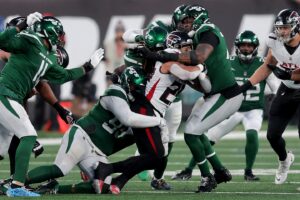The Kansas City Chiefs are now 5-1, falling to the Pittsburgh Steelers to lose their perfect run. Analytically and conceptually the Steelers capitalized on almost all the offensive and defensive concerns the Chiefs displayed over the first five games of the season. The Steelers have now been able to efficiently beat the Chiefs over the past several seasons. More than just winning, Mike Tomlin schemed his physical assets to box in the Chiefs to their worst play sets. Tomlin defeated Andy Reid in a way that no other coach has been able to; it was a masterpiece of desperate ingenuity as Tomlin created the perfect scenario for his players to succeed. The Chiefs week six stats not only provide a way to beat the Chiefs, but make evident direct implications of the one or two plays that display championship teams.
Kansas City Chiefs Week Six Stats and Charts – The Corner of the Boxing Ring
Chaos Theory
The entirety of Sunday’s contest for Kansas City was an up and down battle of trying to garnish control back. Assertion was quickly made by the Steelers, and subsequently never let go. In essence, the Steelers controlled chaos throughout the tenure of the entire game and managed play calling scenarios with more preciseness than the Chiefs. The Steelers stole a picture out of the Chiefs usual template of controlled precision in their 19-13 victory.
The opening drive for the Steelers was a mix of Steelers running back Le’Veon Bell scorching, then Dee Ford landing a sack ultimately forcing a punt. Chaos was functionally in the hands of the Chiefs. Yet, immediately after getting the ball, on a second and 17 the Chiefs lost complete control of the game.
Center Zach Fulton put a snap high over the head of Alex Smith resulting in a safety. Not only was the safety an egregious mistake that gave the Steelers a 2-0 lead, but it took the air out of the stadium. However, it was a recoverable offense. Teams that have given up a safety in the first quarter were 35-49 since 1994 (now 35-50).
One of the intriguing notes in chaos theory is how teams manage mistakes over the tenure of a game. Making mistakes early counts less for chaos and win probability as the amount of time to recover is extended.
Furthermore, the Chiefs special teams was on point and attempted to provide another early advantage. Antonio Brown accidentally touched the ball, muffing the safety punt. Dave Toub’s burning fast squad was downfield before most of the Steelers, and Jehu Chesson quickly jumped on the ball to give the Chiefs a short field and a shot to manage chaos.
Unfortunately for the Chiefs, the importance of veteran Mitch Morse, who was out with injury, was further established. After the safety, Fulton continued to allow pressure against the Steelers tenacious pass rush. More of a schematic point than a chaos point, but without leaders Morse and Laurent Duvernay-Tardif, the Chiefs offensive unit allowed nine pressures and three sacks, letting the subsequent advanced blitz patterns get to their head.
While the Chiefs managed to kick a field goal and temporarily take control back into their hands, this would be the last time they held the game’s momentum. Immediately afterwards, Ben Roethlisberger went on a 12 play, 75-yard drive to score a touchdown. With physically imposing play and controlling the ball, the Steelers forced chaos down the throats of the Chiefs.
That feeling of chaos was reflected both in the play and play calling. Not even a timely Marcus Peters interception would allow the Chiefs to get back into the game. Throughout the first half, and well into the second half, Reid was forced to abandon the run, and thus lost control of the clock.
One of the most succinct points of chaos theory study (again, saving the nuanced fractals and graphs) is the importance of being able to run the ball and control the clock. A team who can intermix the run, or facsimiles of run plays by short wheel routes or screens, will be able to control the clock and thus the momentum of a game. And Sunday, the Chiefs did not control the clock or momentum. As a result, those chances the Chiefs did have to pull off a miracle (Phillip Gaines’ dropped interception, Smith overthrowing Demarcus Robinson) were expected to fall short according to the analytical robot.
Boxing from a Corner
In boxing, the one thing the competitor wants to avoid above all else is being pushed into the corner and forced to box their way out of it. In getting pushed into a corner, the boxer is up against the ropes, claustrophobia sets in, and the sweat intensifies. Even the most avowed fighters forget their strategy when they get pushed into a corner. Coach Reid was the boxer who got pushed into a corner, lost his whims, and thus lost the overall operating order of the game.
The Chiefs offensive functionality that has been the momentum to setting up the finer points of the play action and deep ball was the run game. The pure box score shows the abysmal performance in this respect as Kareem Hunt ran nine times for 21 yards. Hunt’s longest run of the day was five yards, thus forcing Reid to turn toward Smith to pass his way to victory.
Pushing the run game’s bad narrative is difficult on merely nine carries from Hunt, one from Akeem Hunt, and an attempted jet fly by Hill. However, the blocking and efficiency was inferior to the fit-to-run by the Steelers linebackers. As opposed to previous weeks, the Steelers front seven, specifically Sean Davis, dominated on all trajectories of the field.
Hunt was only able to garnish 13 yards on his five rushes on the edge, and then another eight through the middle and right guard. Even the trusted Mitchell Schwartz was unfulfilling of his assignments. For comparison, on the season, the Chiefs have 5.9 and 14.8 yards per carry behind the center and right guard respectively.
Extrapolating the dominance of the Steelers, Reid tried to work the run on first down. Six of Hunt’s runs came on first down, the usual play call for Hunt to shine. On first down, Hunt has garnered an incredible 7.01 yards per carry on 70 runs for 491 yards. And those runs are his most explosive, averaging three first downs runs per game solely on first down runs. On Sunday, obviously, he had zero.
Moving to the passing game, the problem was not solely the fact Smith had to throw 34 times, was sacked three times, or even the pressures. The pass game is a direct consequence of the run game. Finishing with a 55 percent completion percentage, the problem was the deep ball or passing scheme had no potential to work.
Before this game, Smith has 19 targets in the deep cones of the field. He had the luxury of choosing when to throw deep, setting up those play calls at opportune times. Against the Steelers, Smith attempted eight targets into the deep cones of the field, compiling four completions for 125 yards and a touchdown.
Tossing for 125 yards is a game most quarterbacks would welcome. Yet, in the context of the Chiefs scheme, Smith struggles when he is forced to throw deep opposed to taking shots by the opportunities intrinsically built into a plan.
Further, 57 of those yards and the touchdown came on one incredible De’Anthony Thomas reception as Smith escaped pressure, and Thomas finished the play with athleticism of his own. All four of those completions came on the deep left cone – a clear area of blown coverage for the Steelers secondary.
Although Reid took advantage of the Steelers propensity for blown coverage on the left side, he still was forced to change his plan early and play from the corner of a boxing ring the entire game.
Extrapolating the passing game’s problems further, the Steelers are excellent at eliminating yards after the catch on short targets. This is exemplified in several ways, foremost Tyreek Hill having a long reception of ten yards, and kept to 34 yards on five receptions. The five receptions is good, the 34 yards are not – the aim is for Hill to turn those five short receptions into two or more explosive plays.
Finally, finishing on a strong point, Hunt showed he is a formidable target downfield. He finished the day as the leading receiver, catching five receptions for 89 yards and a long of 37. The implication is two-fold. First, Hunt’s exceptional vision and quick agility is functional downfield as it has been at the line of scrimmage.
Second, the concepts that Hunt is worked into are highly functional and successful, showing a positive of Reid’s route systems. Hunt had two receptions on the right side, but was held to four yards. On the short right, mostly used in the wheel route, he had two receptions for 56 yards. On his sole deep left, wheel target, he had 29 yards. Hence, the decoy routes that Travis Kelce and Hill run work even if they are not shining during the day.
Defensive coordinators respect the Chiefs physical targets for 60 minutes regardless of the situation or score; and that stands as a huge positive over the stretch of a season.
Managing Wounds
The Chiefs defensive unit gave up 19 points, an impressive feat figuring the 252 yards surrendered to Roethlisberger on only 17 completions, and the disastrous 179 yards given up to Bell on the ground. They managed to stick to the ‘bend but not break’ strategy, but in doing so, broke enough times the Steelers controlled the ball for 36:39 and gained 23 first downs.
Bob Sutton spent most of his afternoon trying to control bleeding and managing a way for the offense to get the ball back. Time and time again, when it appeared the Chiefs had the Steelers cornered, either Brown or Bell scorched the defense. Yet, pushing the Steelers to their third-down corner of the boxing ring was rarely completed.
On third down, the Steelers ran ten plays – two runs and eight passes. One of those runs was an explosive play as Bell garnished a first down on a ten-yard run. The latter was a short-yard conversion by Terrell Watson. Roethlisberger was disastrous on third down, going 3/8, with an interception and a sack.
The interception mark ought to have been two, and no touchdowns. Yet, Brown made the play of the game when Gaines bobbled an interception and somehow the ball fell to Brown. He ran the remainder of the field for a touchdown. Without that one play, the Chiefs would have held the Steelers to three first downs on ten attempts and 37 yards.
In short, less one play, the Chiefs managed the bleeding. However, without focus in one singular moment, the game was potentially lost. A truly impressive notion to the fact football demands excellence for 60 minutes.
No matter, the emphasis that set up the long third-down could have been prevented by stopping the Steelers on first and second down. The Steelers had 32 plays on first down, and converted 12 of those to instantaneous first downs. Bell averaged 5.71 yards per carry on first down alone.
Second down saw 20 plays, with Bell averaging 4.9 yards per carry, and Roethlisberger finding his target six of seven times.
Thus, in between the Bell’s eight explosive runs, and an additional one by James Conner, the Steelers simply chunked the ball. They could not be backed into a corner. A lack of commitment to technique and fit to run enabled this.
Implosion also incurred in the secondary as a consequence of an anemic pass rush. After Ford’s initial sack, the Chiefs failed to generate pressure, much less a sack. Justin Houston was crossed over in coverage too much, and when he did blitz, he failed to generate any pressure. The running game effectively put the Chiefs on their heels after the first drive. A lack of tenacity gave Roethlisberger clear passing lanes over the middle of the field.
The synthesis of the defensive performance is the fact the Chiefs can control bleeding. They are a mature unit, and if they capitalize throughout the game, they can create comeback opportunities. However, the explosive gashes kept the bleeding flowing and ongoing.
Without an upfront or physical presence, the Chiefs do not generate the confusion and forced mistakes they typically do. Roethlisberger was able to dissect where and when he wanted to, without the need to force uncomfortable throws. The Steelers just ran when they wanted.
Roethlisberger is fairly good managing games where he does not have to throw much. When throwing 25 times or less, he is 45-5, averaging 196 yards passing and two touchdowns. Further, he is 5-1 in the playoffs.
To capitalize everything, in the Sutton era, only seven starting quarterbacks (leaving the game healthy) have attempted 25 or fewer passes on the Chiefs, and in those games, the Chiefs hold a 4-3 record. Two of those losses: Roethlisberger, making the Steelers the bane of killing the Chiefs on all three planes of the game.
(Andy Dalton was the other loss, when the Chiefs surrendered 124 yards and four touchdowns on the ground to the Cincinnati Bengals.)
Main Image:






